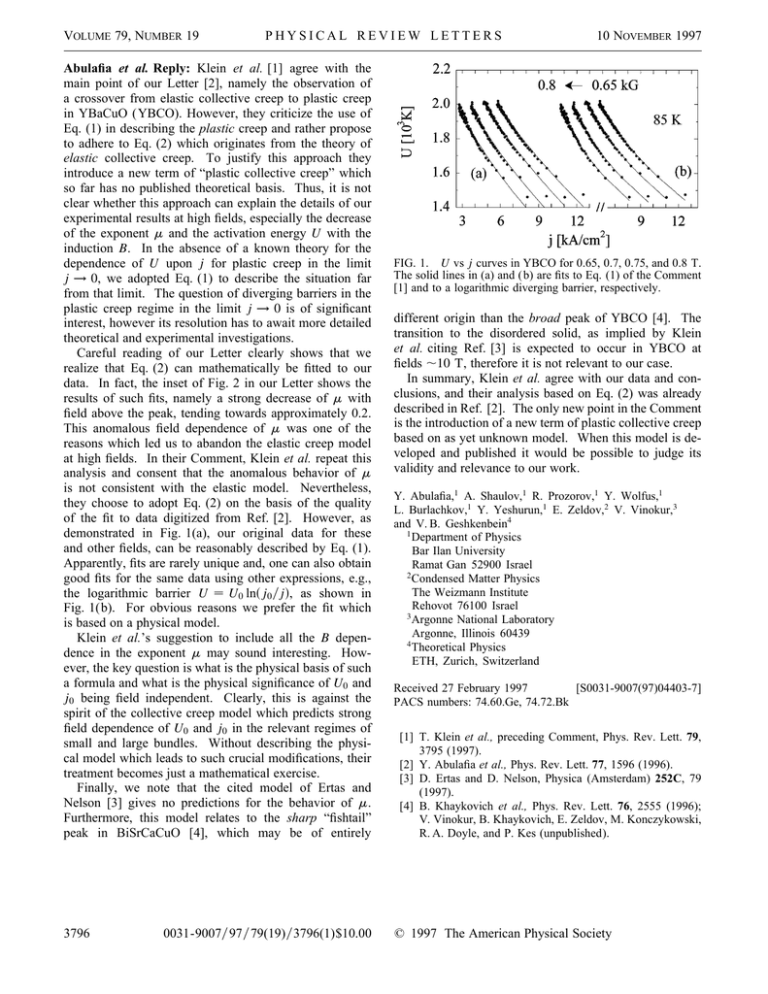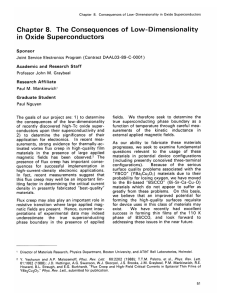V 79, N 19
advertisement

VOLUME 79, NUMBER 19 PHYSICAL REVIEW LETTERS Abulafia et al. Reply: Klein et al. [1] agree with the main point of our Letter [2], namely the observation of a crossover from elastic collective creep to plastic creep in YBaCuO (YBCO). However, they criticize the use of Eq. (1) in describing the plastic creep and rather propose to adhere to Eq. (2) which originates from the theory of elastic collective creep. To justify this approach they introduce a new term of “plastic collective creep” which so far has no published theoretical basis. Thus, it is not clear whether this approach can explain the details of our experimental results at high fields, especially the decrease of the exponent m and the activation energy U with the induction B. In the absence of a known theory for the dependence of U upon j for plastic creep in the limit j ! 0, we adopted Eq. (1) to describe the situation far from that limit. The question of diverging barriers in the plastic creep regime in the limit j ! 0 is of significant interest, however its resolution has to await more detailed theoretical and experimental investigations. Careful reading of our Letter clearly shows that we realize that Eq. (2) can mathematically be fitted to our data. In fact, the inset of Fig. 2 in our Letter shows the results of such fits, namely a strong decrease of m with field above the peak, tending towards approximately 0.2. This anomalous field dependence of m was one of the reasons which led us to abandon the elastic creep model at high fields. In their Comment, Klein et al. repeat this analysis and consent that the anomalous behavior of m is not consistent with the elastic model. Nevertheless, they choose to adopt Eq. (2) on the basis of the quality of the fit to data digitized from Ref. [2]. However, as demonstrated in Fig. 1(a), our original data for these and other fields, can be reasonably described by Eq. (1). Apparently, fits are rarely unique and, one can also obtain good fits for the same data using other expressions, e.g., the logarithmic barrier U ­ U0 lnsj0 yjd, as shown in Fig. 1(b). For obvious reasons we prefer the fit which is based on a physical model. Klein et al.’s suggestion to include all the B dependence in the exponent m may sound interesting. However, the key question is what is the physical basis of such a formula and what is the physical significance of U0 and j0 being field independent. Clearly, this is against the spirit of the collective creep model which predicts strong field dependence of U0 and j0 in the relevant regimes of small and large bundles. Without describing the physical model which leads to such crucial modifications, their treatment becomes just a mathematical exercise. Finally, we note that the cited model of Ertas and Nelson [3] gives no predictions for the behavior of m. Furthermore, this model relates to the sharp “fishtail” peak in BiSrCaCuO [4], which may be of entirely 3796 0031-9007y97y79(19)y3796(1)$10.00 10 NOVEMBER 1997 FIG. 1. U vs j curves in YBCO for 0.65, 0.7, 0.75, and 0.8 T. The solid lines in (a) and (b) are fits to Eq. (1) of the Comment [1] and to a logarithmic diverging barrier, respectively. different origin than the broad peak of YBCO [4]. The transition to the disordered solid, as implied by Klein et al. citing Ref. [3] is expected to occur in YBCO at fields ,10 T, therefore it is not relevant to our case. In summary, Klein et al. agree with our data and conclusions, and their analysis based on Eq. (2) was already described in Ref. [2]. The only new point in the Comment is the introduction of a new term of plastic collective creep based on as yet unknown model. When this model is developed and published it would be possible to judge its validity and relevance to our work. Y. Abulafia,1 A. Shaulov,1 R. Prozorov,1 Y. Wolfus,1 L. Burlachkov,1 Y. Yeshurun,1 E. Zeldov,2 V. Vinokur,3 and V. B. Geshkenbein4 1 Department of Physics Bar Ilan University Ramat Gan 52900 Israel 2 Condensed Matter Physics The Weizmann Institute Rehovot 76100 Israel 3 Argonne National Laboratory Argonne, Illinois 60439 4 Theoretical Physics ETH, Zurich, Switzerland Received 27 February 1997 [S0031-9007(97)04403-7] PACS numbers: 74.60.Ge, 74.72.Bk [1] T. Klein et al., preceding Comment, Phys. Rev. Lett. 79, 3795 (1997). [2] Y. Abulafia et al., Phys. Rev. Lett. 77, 1596 (1996). [3] D. Ertas and D. Nelson, Physica (Amsterdam) 252C, 79 (1997). [4] B. Khaykovich et al., Phys. Rev. Lett. 76, 2555 (1996); V. Vinokur, B. Khaykovich, E. Zeldov, M. Konczykowski, R. A. Doyle, and P. Kes (unpublished). © 1997 The American Physical Society






